
Dandy

 1. A bracket. And some wear and tear just above it. It could very well have been a headlight bracket and that it was often used.
1. A bracket. And some wear and tear just above it. It could very well have been a headlight bracket and that it was often used. 2. A builders illustration including a headlight. It also depicts how the headlight sits low and rests on the front bumper (?).
2. A builders illustration including a headlight. It also depicts how the headlight sits low and rests on the front bumper (?). 3. Historical conformation of just such an arrangement. Pacific Electric 1001, which still exists today, sports a same sort headlamp. It fits onto a braket and you can see how a cord extends from it and has to be plugged in.
3. Historical conformation of just such an arrangement. Pacific Electric 1001, which still exists today, sports a same sort headlamp. It fits onto a braket and you can see how a cord extends from it and has to be plugged in. Precision Scale Co. Incandescent Headlamp For Interurban Cars #31004 seems to fit the bill quite nicely. The sprue on the back has to be cut off and then I filed the back for a good fit on the car. While I'm at it, I'll add the retriever fabricated from a 3/64" brass rod.
Precision Scale Co. Incandescent Headlamp For Interurban Cars #31004 seems to fit the bill quite nicely. The sprue on the back has to be cut off and then I filed the back for a good fit on the car. While I'm at it, I'll add the retriever fabricated from a 3/64" brass rod.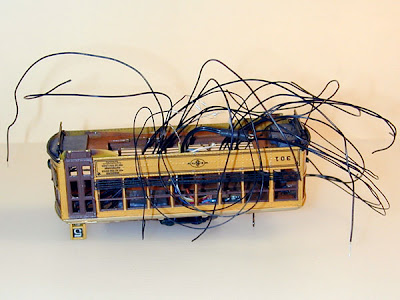 This disaster blew the wind out of my sails. I focused on other aspects of life for a while. Then, after a sufficient time of pouting, I'm back. Birney has been disassembled, blown bulbs ripped out, and new bulbs installed.
This disaster blew the wind out of my sails. I focused on other aspects of life for a while. Then, after a sufficient time of pouting, I'm back. Birney has been disassembled, blown bulbs ripped out, and new bulbs installed. Trolley poles pointing downward is a bad thing. The hold down hooks are too short. So I'm going to fabricate some new hooks that are taller and more prototypically correct.
Trolley poles pointing downward is a bad thing. The hold down hooks are too short. So I'm going to fabricate some new hooks that are taller and more prototypically correct. Since the trolley poles are wired to the leads of the motor, the hooks need to conduct electricity from the brass body of the car to the pole. So I had to remove paint from where the hooks will be soldered to the car.
Since the trolley poles are wired to the leads of the motor, the hooks need to conduct electricity from the brass body of the car to the pole. So I had to remove paint from where the hooks will be soldered to the car. To fabricate the hold down hooks, I started with .010" x .030" brass bar stock folded in half.
To fabricate the hold down hooks, I started with .010" x .030" brass bar stock folded in half. Using a nail (I found a nail that was the same diameter of the old hook loop) I looped the brass around getting a nice curve by using pliers and a screwdriver to work the brass into shape.
Using a nail (I found a nail that was the same diameter of the old hook loop) I looped the brass around getting a nice curve by using pliers and a screwdriver to work the brass into shape. Add a reverse curve in the brass so that the apex of the loop is in line with the main shaft of the hook. Solder only the loop, the reverse curve and part of the neck together.
Add a reverse curve in the brass so that the apex of the loop is in line with the main shaft of the hook. Solder only the loop, the reverse curve and part of the neck together. Then bend the legs out and fold in the feet that will be soldered to the base. The hook assembly is now done.
Then bend the legs out and fold in the feet that will be soldered to the base. The hook assembly is now done. Solder the hook assembly to the roof boards and trim the feet. Give it a tug to confirm a good connection. Now its time to paint the hooks and while I'm at it, I'm going to right a wrong...
Solder the hook assembly to the roof boards and trim the feet. Give it a tug to confirm a good connection. Now its time to paint the hooks and while I'm at it, I'm going to right a wrong... Roof boards were never the same color as the roof. Roofs were usually of canvas or thin sheet metal, so you don't want to step on it or you'll fall right through or bend the heck out of it. So roof boards were installed so that workmen maintaining the cars could stand on the roof without damaging it. They were usually made of wood and were painted a contrasting color so the workmen could see where to step out of their peripheral vision. My hands are pretty steady, but not at this tiny scale. So I masked off around the boards.
Roof boards were never the same color as the roof. Roofs were usually of canvas or thin sheet metal, so you don't want to step on it or you'll fall right through or bend the heck out of it. So roof boards were installed so that workmen maintaining the cars could stand on the roof without damaging it. They were usually made of wood and were painted a contrasting color so the workmen could see where to step out of their peripheral vision. My hands are pretty steady, but not at this tiny scale. So I masked off around the boards. Brushed on some Scalecoat Roof Brown on the boards and painted the hooks black. Some weathering will kill the shine on the boards.
Brushed on some Scalecoat Roof Brown on the boards and painted the hooks black. Some weathering will kill the shine on the boards. Now that's more like it! The car looks much better and the horizontal poles are getting a much better electrical contact with the hooks now. Storing the car with poles on help keep the connection from oxidizing. Got to do everything you can to keep good electrical connections throughout if you want to keep them doggies rollin'. Yes sir! Keep them doggies rollin'!
Now that's more like it! The car looks much better and the horizontal poles are getting a much better electrical contact with the hooks now. Storing the car with poles on help keep the connection from oxidizing. Got to do everything you can to keep good electrical connections throughout if you want to keep them doggies rollin'. Yes sir! Keep them doggies rollin'! Suydam, for whatever reason, positioned the seats so that they face the ends. Since my cars are going to be working cars, I want them all to face the same direction, like the real deal did.
Suydam, for whatever reason, positioned the seats so that they face the ends. Since my cars are going to be working cars, I want them all to face the same direction, like the real deal did.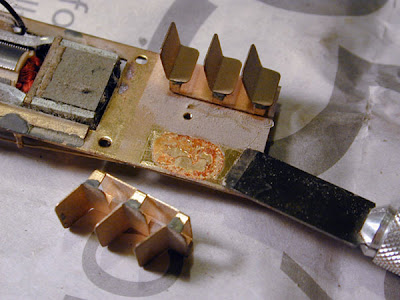 The seats pop off easily with the pry of a knife. I found this out after spending a lot of time and butane trying to de-solder them. Everything else was coming unsoldered but the dang seats! Turns out they're glued on. So... yeah, pop them off with a knife.
The seats pop off easily with the pry of a knife. I found this out after spending a lot of time and butane trying to de-solder them. Everything else was coming unsoldered but the dang seats! Turns out they're glued on. So... yeah, pop them off with a knife.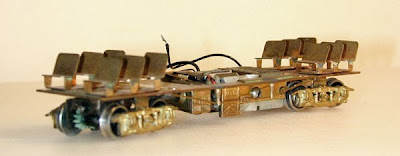

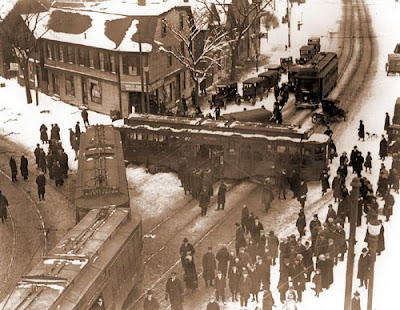 But to you, my loyal followers, I hope that you do derive some sort of value from this train wreck of a blog. Even if you are laughing at me rather than with me. If your learning from the stupid mistakes I'm making here, then the world is a better place. I have made a difference.
But to you, my loyal followers, I hope that you do derive some sort of value from this train wreck of a blog. Even if you are laughing at me rather than with me. If your learning from the stupid mistakes I'm making here, then the world is a better place. I have made a difference. In all truthfulness, I'm actually having a blast maintaining this blog (and my happiness is whats really important, right? Right). I find that feeding the ferocious appetite of this blog keeps me focused and moving forward on my projects. Which is good, cuz I've got a lot to do if I want to get anywhere near completing this layout to the ridiculous standards I have set for it.
In all truthfulness, I'm actually having a blast maintaining this blog (and my happiness is whats really important, right? Right). I find that feeding the ferocious appetite of this blog keeps me focused and moving forward on my projects. Which is good, cuz I've got a lot to do if I want to get anywhere near completing this layout to the ridiculous standards I have set for it. So rest assured that more good stuff is on the way, I don't intend on stopping any time soon. This next year is looking good, the Niles project is well underway and is going well. I have a YouTube account set up so that I can start adding videos to this blog. And I'm learning a ton from they guys at the Southern California Traction Club that I intend to share with you on this site. So here's to a great big beautiful tomorrow! Yes sir! A great big beautiful tomorrow.
So rest assured that more good stuff is on the way, I don't intend on stopping any time soon. This next year is looking good, the Niles project is well underway and is going well. I have a YouTube account set up so that I can start adding videos to this blog. And I'm learning a ton from they guys at the Southern California Traction Club that I intend to share with you on this site. So here's to a great big beautiful tomorrow! Yes sir! A great big beautiful tomorrow.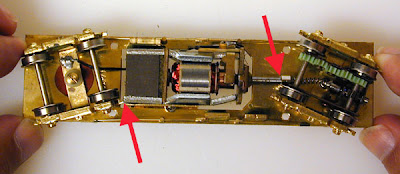 The side frame of the truck on the left is contacting the motor. Hopefully the new BullAnt motor will eliminate this problem. While the truck on the right, the drive shaft is contacting the wheel (or gear when rotated the other way). There isn't a whole lot I can do about that. Fortunately, this truck has a tighter turning radius than the other.
The side frame of the truck on the left is contacting the motor. Hopefully the new BullAnt motor will eliminate this problem. While the truck on the right, the drive shaft is contacting the wheel (or gear when rotated the other way). There isn't a whole lot I can do about that. Fortunately, this truck has a tighter turning radius than the other. The signboard and retriever are really the only things that need to be removed. The Point Loma car (on the left) had a different pilot, so I removed that too. As you can also see on the Point Loma car, the removal of the signboard left a mounting slot and holes on the roof.
The signboard and retriever are really the only things that need to be removed. The Point Loma car (on the left) had a different pilot, so I removed that too. As you can also see on the Point Loma car, the removal of the signboard left a mounting slot and holes on the roof.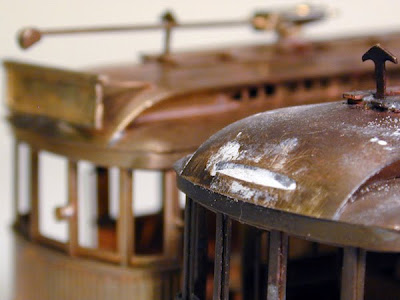 To fill in this slot, I used Squadron white modeling putty. Its readily available, really easy to use, and dries fast. I simply squeezed a small amount out onto a piece of card and applyed with a small screwdriver. After it dried I sanded it down flush.
To fill in this slot, I used Squadron white modeling putty. Its readily available, really easy to use, and dries fast. I simply squeezed a small amount out onto a piece of card and applyed with a small screwdriver. After it dried I sanded it down flush. As for the trucks... In San Diego the cars had a 6 foot wheel base while the model sports the PE 5'4" wheelbase with 30" wheels. I'm afraid that if I go with the longer wheelbase, it might jeopardize the turning radius that the car can make. As-is, the trucks are making contact with the motor on my curves. The new BullAnt motor should eliminate this problem, but the drive shaft from the motor to the truck is what is going to limit its turning ability now. Another factor as to whether or not to change the trucks is if the side frames are available commercially. Because if they're not...
As for the trucks... In San Diego the cars had a 6 foot wheel base while the model sports the PE 5'4" wheelbase with 30" wheels. I'm afraid that if I go with the longer wheelbase, it might jeopardize the turning radius that the car can make. As-is, the trucks are making contact with the motor on my curves. The new BullAnt motor should eliminate this problem, but the drive shaft from the motor to the truck is what is going to limit its turning ability now. Another factor as to whether or not to change the trucks is if the side frames are available commercially. Because if they're not...
 This model will become SD&SE #107 (I have other plans for #105. See below) with the nice monogram logo on the sides.
This model will become SD&SE #107 (I have other plans for #105. See below) with the nice monogram logo on the sides. This model volunteered to become the Point Loma car when it lost it pilot! Originally I was going to go with the 402 number, but I have since decided to use its original number to help separate it from the SDERy class 5, 400 series cars that would come later.
This model volunteered to become the Point Loma car when it lost it pilot! Originally I was going to go with the 402 number, but I have since decided to use its original number to help separate it from the SDERy class 5, 400 series cars that would come later. Okay, I'm going to use a little modelers license here. #105 didn't become a combination car until it was in the hands of the PE. But I'm going to do a "what if". SD&SE #101 (non-Niles car pictured above) was involved in an accident and was rebuilt into a combination car. But "what if" it was #105 that was in the accident instead? I'm mean, why not? It became a combo car eventually.
Okay, I'm going to use a little modelers license here. #105 didn't become a combination car until it was in the hands of the PE. But I'm going to do a "what if". SD&SE #101 (non-Niles car pictured above) was involved in an accident and was rebuilt into a combination car. But "what if" it was #105 that was in the accident instead? I'm mean, why not? It became a combo car eventually. The National City & Otay Railway, in 1908, ordered the six cars from Niles, numbered 105 - 110, to run on the 13 mile electric portion of NC&O's steam line from San Diego south to National City, Chula Vista and eventually Otay. Before the company took possession of the cars, the NC&O and Coronado Railroad were consolidated to become the San Diego Southern Railway.
The National City & Otay Railway, in 1908, ordered the six cars from Niles, numbered 105 - 110, to run on the 13 mile electric portion of NC&O's steam line from San Diego south to National City, Chula Vista and eventually Otay. Before the company took possession of the cars, the NC&O and Coronado Railroad were consolidated to become the San Diego Southern Railway. Cars 105, 106 and 107 were retained by the San Diego Southern, but cars 108, 109 and 110 went to the Point Loma Railroad Co. The Point Loma line came under control of the San Diego Electric between 1909 and 1910, who changed the cars numbers to 401, 402 and 400 respectively. The numbers weren't changed on the cars themselves until 1911.
Cars 105, 106 and 107 were retained by the San Diego Southern, but cars 108, 109 and 110 went to the Point Loma Railroad Co. The Point Loma line came under control of the San Diego Electric between 1909 and 1910, who changed the cars numbers to 401, 402 and 400 respectively. The numbers weren't changed on the cars themselves until 1911. Around 1910, the Point Loma Railroad had car 110 repainted a chocolate brown and it became a very popular Sight Seeing Car. It ran over much of the San Diego Electrics lines, far from Point Loma.
Around 1910, the Point Loma Railroad had car 110 repainted a chocolate brown and it became a very popular Sight Seeing Car. It ran over much of the San Diego Electrics lines, far from Point Loma. The San Diego Southern lasted only a short 4 years before merging with the San Diego & Cuyamaca Railway to become the San Diego & South Eastern Railway in 1912. Note the nifty SD&SE monogram on car 105 (above). Car 105 would last the longest of the six. By 1915, San Diego Electric decided that their class 2 cars were more economical than the big interurbans and so retired the Niles cars.
The San Diego Southern lasted only a short 4 years before merging with the San Diego & Cuyamaca Railway to become the San Diego & South Eastern Railway in 1912. Note the nifty SD&SE monogram on car 105 (above). Car 105 would last the longest of the six. By 1915, San Diego Electric decided that their class 2 cars were more economical than the big interurbans and so retired the Niles cars. 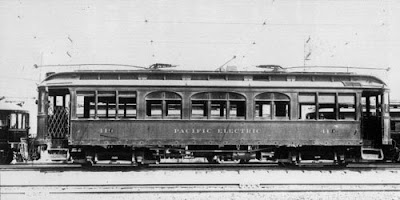 All of the Niles cars were sold to the Pacific Electric in 1918. PE renumbered them 413- 418. Then 413 (ol' #105) was renumbered to 419, and ran under that number until 1933, when the other Niles cars were scrapped. 419 for whatever reason was spared and swapped numbers with PE 474.
All of the Niles cars were sold to the Pacific Electric in 1918. PE renumbered them 413- 418. Then 413 (ol' #105) was renumbered to 419, and ran under that number until 1933, when the other Niles cars were scrapped. 419 for whatever reason was spared and swapped numbers with PE 474. The first of these cars (the center one with all the tarnish) I bought some 25 years ago (good lord how time flies!!!)!!! But despite my best efforts and determination, I could never get it to run properly. I wired it for overhead. I made modifications so that it could take tighter radius curves. But it still ran way to fast and jerky. I later discovered that a gear was slipping. How on earth do I fix that?! So it languished, not a favorite of mine.
The first of these cars (the center one with all the tarnish) I bought some 25 years ago (good lord how time flies!!!)!!! But despite my best efforts and determination, I could never get it to run properly. I wired it for overhead. I made modifications so that it could take tighter radius curves. But it still ran way to fast and jerky. I later discovered that a gear was slipping. How on earth do I fix that?! So it languished, not a favorite of mine.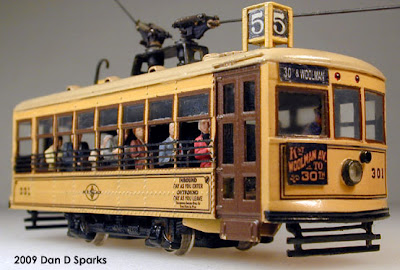
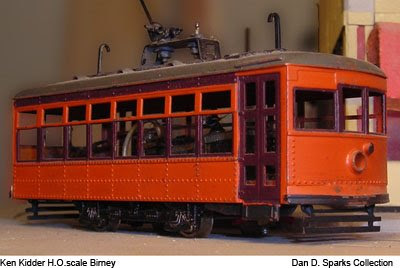 This is what I started with. An eBay basket case birney just begging to be rebuilt.
This is what I started with. An eBay basket case birney just begging to be rebuilt.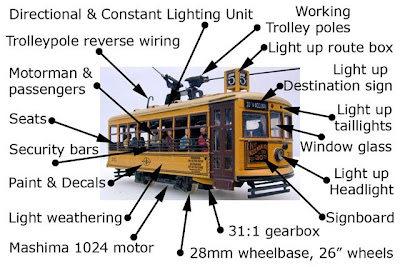 But If you want a more detailed play-by-play of its construction, here is the table of contents for this project:
But If you want a more detailed play-by-play of its construction, here is the table of contents for this project:

 I brought along #301 to show to them and ask general questions about traction modeling. The members were immediately taken with the model and put it on their track. It was the first time I've ever seen the trolley run! Pretty darn exciting.
I brought along #301 to show to them and ask general questions about traction modeling. The members were immediately taken with the model and put it on their track. It was the first time I've ever seen the trolley run! Pretty darn exciting. Above, #301 passes by the SCTC car yards. Displayed in their yards are the pre-production models of the San Fransisco "F Line" PCC Streetcars by Bowser. SCTC was instrumental in the development of these models. George Huckaby’s “Hollywood” car 717 stands ready on the curve. George Huckaby photo.
Above, #301 passes by the SCTC car yards. Displayed in their yards are the pre-production models of the San Fransisco "F Line" PCC Streetcars by Bowser. SCTC was instrumental in the development of these models. George Huckaby’s “Hollywood” car 717 stands ready on the curve. George Huckaby photo. Three things were immediately apparent about the Birney. One, it runs really slow! I might have overdone the 30:1 gear ratio a bit. Second, the motor/gears are really noisy. But the club members assured me that all that will quiet down as the car is broken in. And third, as I suspected, the lights didn't light. But over all the car performed really well. My thanks goes out to the SCTC for indulging me like that.
Three things were immediately apparent about the Birney. One, it runs really slow! I might have overdone the 30:1 gear ratio a bit. Second, the motor/gears are really noisy. But the club members assured me that all that will quiet down as the car is broken in. And third, as I suspected, the lights didn't light. But over all the car performed really well. My thanks goes out to the SCTC for indulging me like that. I am really impressed with the clubs modeling. The long straightaways obtainable by lining up the modules look like they go on forever.
I am really impressed with the clubs modeling. The long straightaways obtainable by lining up the modules look like they go on forever. The clubs modular layout is about at its limit with how much bigger it can get. So now they are concentrating on detailing the scenes.
The clubs modular layout is about at its limit with how much bigger it can get. So now they are concentrating on detailing the scenes. Impressive. So impressive in fact, I joined the club! That's right, I am club member #13. Yessir! Southern California Traction Club member #13!
Impressive. So impressive in fact, I joined the club! That's right, I am club member #13. Yessir! Southern California Traction Club member #13!